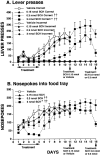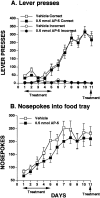Appetitive instrumental learning requires coincident activation of NMDA and dopamine D1 receptors within the medial prefrontal cortex
- PMID: 11826135
- PMCID: PMC6758518
- DOI: 10.1523/JNEUROSCI.22-03-01063.2002
Appetitive instrumental learning requires coincident activation of NMDA and dopamine D1 receptors within the medial prefrontal cortex
Abstract
Through its complex role in cognition, memory, and emotion, the mammalian prefrontal cortex is thought to contribute to the organization of adaptive behavioral actions. In the present studies we examined the role of dopaminergic D1 and glutamatergic NMDA receptors within the prefrontal cortex of the rat during the development of adaptive instrumental learning. Hungry rats with bilateral indwelling cannulas aimed at the medial prefrontal cortex were trained to lever-press for food. Infusion of the selective D1 antagonist SCH-23390 (0.15, 0.3, 3.0 nmol) dose-dependently impaired acquisition of this behavior. Higher doses also impaired expression of this task. Co-infusion of the lowest dose of SCH 23390 with a low dose of the NMDA antagonist AP-5 (0.5 nmol), each of which had no effect on learning when infused alone, potently reduced the ability to acquire the response. Inhibition of intracellular protein kinase A with the selective PKA inhibitor Rp-cAMPS also disrupted acquisition, suggesting that PKA is an intracellular substrate for a D1-NMDA receptor interaction. In control experiments, drug infusions that impaired learning did not affect food intake or locomotion, suggesting a specific effect on learning. We hypothesize that coincident detection of D1-NMDA receptor activation and its transcriptional consequences, within multiple sites of a distributed corticostriatal network, may represent a conserved molecular mechanism for instrumental learning.
Figures





References
-
- Baldwin AE, Holahan MR, Sadeghian K, Kelley AE. N-methyl-d-aspartate receptor-dependent plasticity within a distributed corticostriatal network mediates appetitive instrumental learning. Behav Neurosci. 2000;114:84–98. - PubMed
-
- Baldwin AE, Sadeghian K, Kelley AE (2002) Appetitive instrumental learning is impaired by inhibition of cAMP-dependent protein kinase within the nucleus accumbens. Neurobiol Learn Mem, in press. - PubMed
-
- Balleine BW, Dickinson A. Goal-directed instrumental action: contingency and incentive learning and their cortical substrates. Neuropharmacology. 1998;37:407–419. - PubMed
-
- Beckstead RM, Domesick VB, Nauta WJ. Efferent connections of the substantia nigra and ventral tegmental area in the rat. Brain Res. 1979;175:191–217. - PubMed
-
- Beninger RJ, Miller R. Dopamine D1-like receptors and reward-related incentive learning. Neurosci Biobehav Rev. 1998;22:335–345. - PubMed
Publication types
MeSH terms
Substances
Grants and funding
LinkOut - more resources
Full Text Sources
Miscellaneous
